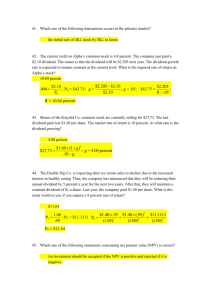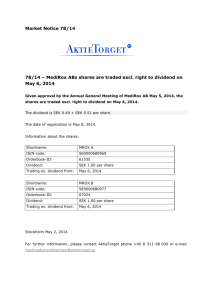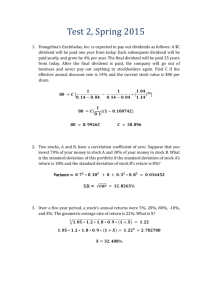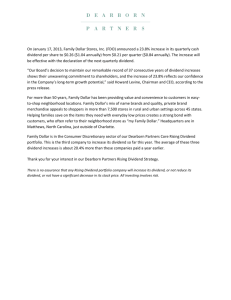declaration of dividend out of reserves and transfer of profits to
advertisement
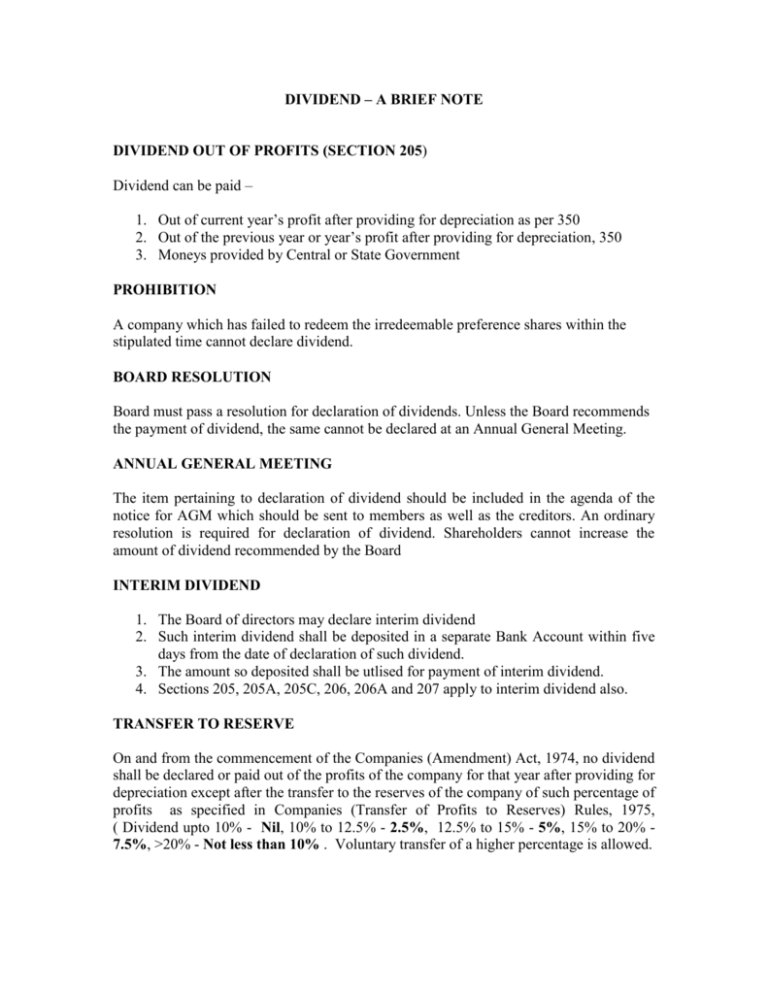
DIVIDEND – A BRIEF NOTE DIVIDEND OUT OF PROFITS (SECTION 205) Dividend can be paid – 1. Out of current year’s profit after providing for depreciation as per 350 2. Out of the previous year or year’s profit after providing for depreciation, 350 3. Moneys provided by Central or State Government PROHIBITION A company which has failed to redeem the irredeemable preference shares within the stipulated time cannot declare dividend. BOARD RESOLUTION Board must pass a resolution for declaration of dividends. Unless the Board recommends the payment of dividend, the same cannot be declared at an Annual General Meeting. ANNUAL GENERAL MEETING The item pertaining to declaration of dividend should be included in the agenda of the notice for AGM which should be sent to members as well as the creditors. An ordinary resolution is required for declaration of dividend. Shareholders cannot increase the amount of dividend recommended by the Board INTERIM DIVIDEND 1. The Board of directors may declare interim dividend 2. Such interim dividend shall be deposited in a separate Bank Account within five days from the date of declaration of such dividend. 3. The amount so deposited shall be utlised for payment of interim dividend. 4. Sections 205, 205A, 205C, 206, 206A and 207 apply to interim dividend also. TRANSFER TO RESERVE On and from the commencement of the Companies (Amendment) Act, 1974, no dividend shall be declared or paid out of the profits of the company for that year after providing for depreciation except after the transfer to the reserves of the company of such percentage of profits as specified in Companies (Transfer of Profits to Reserves) Rules, 1975, ( Dividend upto 10% - Nil, 10% to 12.5% - 2.5%, 12.5% to 15% - 5%, 15% to 20% 7.5%, >20% - Not less than 10% . Voluntary transfer of a higher percentage is allowed. DIVIDEND IN CASH No dividend shall be payable except in cash. UNPAID DIVIDEND TO BE TRANSFERRED TO SPECIAL DIVIDEND ACCOUNT (SECTION 205A) to be opened by the company in that behalf in any scheduled bank to be called “UNPAID DIVIDEND ACCOUNT OF …………….. COMPANY LIMITED / COMPANY (PRIVATE) LIMITED”. If unpaid dividend is not transferred to unpaid dividend account the company shall pay interest @ 12% from the date of such default and the member is entitled to that interest DECLARATION OF DIVIDEND OUT OF RESERVES Where owing to inadequacy or absence of profits in any year, any company proposes to declare dividend out of the accumulated profits earned by the company in previous years and transferred by it to the reserves, such declaration of dividend shall not be made except in accordance with the Companies (Declaration of Dividend out of Reserves) Rules, 1975. Where it is not in accordance with the said rules, Central Government approval is required. Maximum allowed is 10%. . TRANSFER TO CENTRL GOVERNMENT Any amount transferred to unpaid dividend account of a company which remains unpaid or unclaimed for a period of 7 years from the date of such transfer shall be transferred by the company to the Fund established under Sub-section 1 of Section 205C. A company while making such transfer shall furnish a statement setting forth the names, addresses and the amount to which each person is entitled. The company is entitled to get a receipt for the above transfer and such a receipt shall be an effectual discharge of the company in respect thereof. FAILURE Rs.5000/- for every day of default. PAYMENT OF UNPAID OR UNCLAIMED DIVIDEND (SECTION 205 B) Apply to the Central Government and the CG if satisfied will pass an order for payment after getting such security as it may think fit. ESTABLISHMENT OF INVESTOR EDUCATION AND PROTECTION FUND (SECTION 205C) The Central Government shall establish a fund to be called Investor Education and Protection Fund. There shall be credited to the Fund the following funds 1) Amounts in the unpaid dividend accounts of companies 2) Application moneys received by companies for allotment of any securities and due for refund 3) Matured deposits with companies 4) Matured debentures with companies 5) Interest accrued on 1 to 4 above 6) Grants and donations given to the fund by CG / SG / companies / other institutions 7) Interest or other income of the Fund No such amounts 1 to 4 above shall form part of the Fund unless such amounts have remained unclaimed and unpaid for a period of 7 years from the date they became due for payment. No claims shall like against the Fund or the company in respect of individual amounts which were unclaimed and unpaid for a period of 7 years from the dates that first became due for payment and no payment shall be made in respect of any such claims The Fund shall be utilized for promotion of investors’ awareness and protection of the interests of investors. DIVIDEND TO BE PAID TO REGISTERED SHAREHOLDERS OR TO THEIR ORDER TO THEIR BANKERS (SECTION 206) RIGHT TO DIVIDEND, RIGHTS SHARES AND BONUS SHARES TO BE HELD IN ABEYANCE DURING REGISTRATION OF TRANSFER OF SHARES (SECTION 206A) PENALTY FOR FAILURE TO DISTRIBUTE DIVIDENDS WITHIN 30 DAYS (SECTION 207) Where dividend not paid or warrant not posted within 30 days, every director if he is knowingly a party to the default shall be punishable with simple imprisonment for which extend to 3 years and a fine of Rs.1000/- for every day of default plus 18% simple interest during the period the default continues. CIRCUMSTANCES UNDER WHICH DIVIDENT NEED NOT BE PAID 1. Where dividend could not be paid by reason of operation of any law 2. Where shareholder has given directions regarding payment of dividend and those directions cannot be complied with 3. Where there is a dispute regarding the right to receive the dividend 4. Where dividend is adjusted against any sum due from the shareholder 5. Where failure to pay or post dividend warrant was not due to any default on the part of the company. TAX LIMIT In addition to the income tax chargeable in respect of the total income of a company for any assessment year, any amount declared, distributed or paid by such company by way of dividends (whether interim or otherwise) and also whether paid out of current or accumulated profits is charged with additional tax at the rate of 15 %.[4] The liability of payment of tax is on the principle officer of the company. The tax has to be paid within 14 days of declaration, distribution or payment of any dividend whichever is the earliest. The tax on distributed profit paid by the Company would be treated as the final payment of tax in respect of dividend. LISTED COMPANY PROVISIONS In addition to the steps mentioned above the listed companies also have to advance intimation regarding the venue of the Board Meeting to the stock exchange where the securities are listed. Within 15 minutes of the closure of the Board meeting, intimation is also to be sent to the stock exchange containing the particulars of dividend. Details regarding the general meeting for the declaration of dividend are also to be given to the Stock Exchange. DECLARATION OF DIVIDEND OUT OF RESERVES AND TRANSFER OF PROFITS TO RESERVES RULES A. COMPULSORY TRANSFER TO RESERVES 1. No amount need be transferred to Reserves if the dividend declared does not exceed 10%. 2. No dividend can be declared and paid in excess of 10% unless minimum amount prescribed as under is transferred to Reserves. Rate of dividend % of current profits exceeding up to 10.0% 12.5% 2.5% 12.5% 15.0% 5.0% 15.0% 20.0% 7.5% 20.0% 10.0% 3. According to the department, Profits for this purpose, have to be taken as net after deducting depreciation (including all arrears), statutory transfer to Reserves, taxation etc. and including therein, other adjustments such as transfer from statutory reserves after compulsory period is over, taxation or other provisions pertaining to previous year no longer required etc. 4. According to the department, transfer to Reserves includes only transfer to free reserves and does not include any other transfer such as investment allowance Reserve etc. B. VOLUNTARY TRANSFER TO RESERVES 1. Rules have been prescribed for transferring to reserves in excess of 10% of profits. There is no restriction on transfer up to 10% of profits. 2. The Rules are as under a. Where a dividend is declared and the net profit after tax is lower by 20% or more than the average net profit after tax of the two immediately preceding financial years — no conditions are to be fulfilled. b. Where a dividend is declared and not covered under (a) above, the dividend should be at a rate at least equal to the average of the rates at which dividends were declared in the immediately preceding three years, provided that, where bonus shares have been issued in the financial year in which the dividend is declared or in any of the three preceding years, the dividend declared should be an amount at least equal to average amount of dividend declared over the three years immediately preceding the financial year. c. Where no dividend is declared, the amount proposed to be transferred to the reserves from the current profits shall be lower than the average amount of dividends declared in the immediately preceding three years. 3. According to the department, whatever profits are not transferred or could not be transferred to Reserves have to be carried forward in the profit and loss account. 4. A new company which does not declare any dividend would not be able to transfer any amount to Reserves in excess of 10% of current profits for first three years according to the view expressed by the Department of Company Affairs, on 26.7.1976. 5. Penalty of up to Rs. 500 with further fine not exceeding Rs. 50 per day for continuing defaults, has been prescribed by the rules, for contravention of the rules. C. DECLARATION OF DIVIDEND OUT OF RESERVES 1. Wherein any year there is a loss, or the profits are inadequate to declare a dividend, the dividend can be declared, out of the accumulated profits earned by the company in previous years and transferred to reserves, subject to certain rules. 2. The following conditions have to be fulfilled before declaring dividend out of reserves : a. Rate of dividend shall not exceed average of rates of dividend declared in preceding 5 yrs subject to a max. of 10%. For calculating average, the "no dividend" yrs have to be included and rate should be taken as NIL. b. The total amount to be withdrawn out of reserves shall not exceed 10% of the aggregate of paid-up capital and free reserves and this amount shall first be utilised to set off the losses incurred in the financial year and the balance only may be utilised to distribute dividend as determined in (a) above. c. The balance in the Reserves shall not fall below 15% of paidup share capital after the amount withdrawn necessary for the purpose of dividend and set off of losses of the current year. 3. The total amount of Reserves shall mean only free Reserves not including any Capital Reserve or Statutory Development Rebate Reserve (amount required by the I.T. Act to be retained in the account). In other words, free reserves will mean only distributable Reserve.



